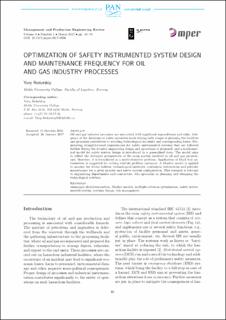| dc.contributor.author | Redutskiy, Yury | |
| dc.date.accessioned | 2023-07-06T11:56:27Z | |
| dc.date.available | 2023-07-06T11:56:27Z | |
| dc.date.created | 2017-03-28T18:26:36Z | |
| dc.date.issued | 2017 | |
| dc.identifier.citation | Management and Production Engineering Review. 2017, 8 (1), 46-59. | en_US |
| dc.identifier.issn | 2080-8208 | |
| dc.identifier.uri | https://hdl.handle.net/11250/3076598 | |
| dc.description.abstract | Oil and gas industry processes are associated with significant expenditures and risks. Adequacy of the decisions on safety measures made during early stages of planning the facilities and processes contributes to avoiding technological incidents and corresponding losses. Formulating straightforward requirements for safety instrumented systems that are followed further during the detailed engineering design and operations is proposed, and a mathematical model for safety system design is introduced in a generalized form. The model aims to reflect the divergent perspectives of the main parties involved in oil and gas projects, and, therefore, it is formulated as a multi-objective problem. Application of black box optimization is suggested for solving real-life problem instances. A Markov model is applied to account for device failures, technological incidents, continuous restorations and periodic maintenance for a given process and safety system configuration. This research is relevant to engineering departments and contractors, who specialize in planning and designing the technological solution. | en_US |
| dc.language.iso | eng | en_US |
| dc.relation.uri | http://mper.org/mper/images/archiwum/2017/nr1/6-redutskiy.pdf | |
| dc.rights | Attribution-NonCommercial-NoDerivatives 4.0 Internasjonal | * |
| dc.rights.uri | http://creativecommons.org/licenses/by-nc-nd/4.0/deed.no | * |
| dc.title | Optimization of safety instrumented system design and maintenance frequency for oil and gas industry processes | en_US |
| dc.type | Peer reviewed | en_US |
| dc.type | Journal article | en_US |
| dc.description.version | publishedVersion | en_US |
| dc.source.pagenumber | 46-59 | en_US |
| dc.source.volume | 8 | en_US |
| dc.source.journal | Management and Production Engineering Review | en_US |
| dc.source.issue | 1 | en_US |
| dc.identifier.doi | 10.1515/mper-2017-0006 | |
| dc.identifier.cristin | 1461859 | |
| cristin.ispublished | true | |
| cristin.fulltext | original | |
| cristin.qualitycode | 1 | |

